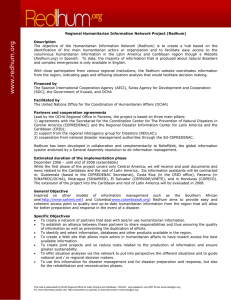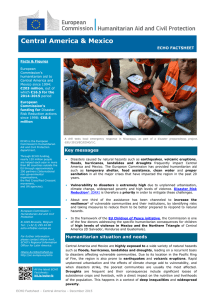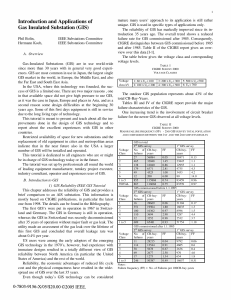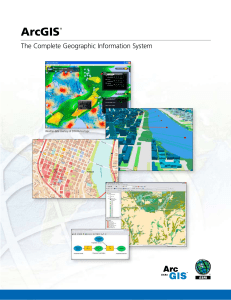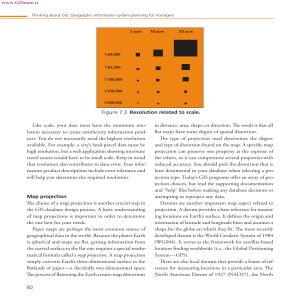GIS for Natural Disaster Management (PDF Available)
Anuncio
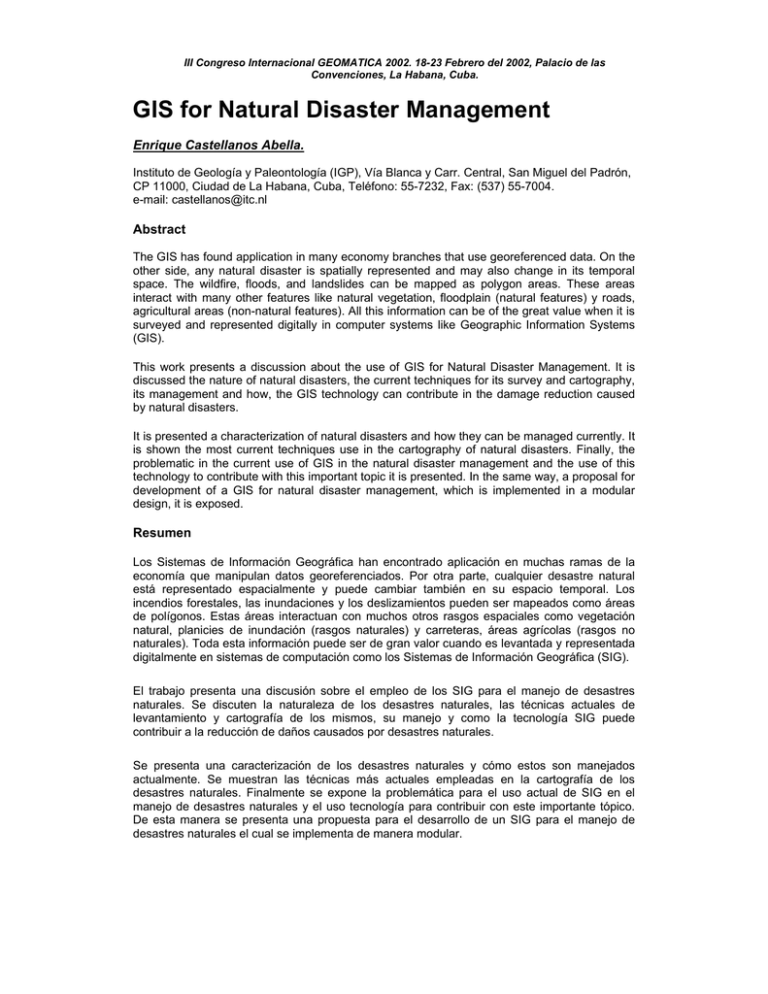
III Congreso Internacional GEOMATICA 2002. 18-23 Febrero del 2002, Palacio de las Convenciones, La Habana, Cuba. GIS for Natural Disaster Management Enrique Castellanos Abella. Instituto de Geología y Paleontología (IGP), Vía Blanca y Carr. Central, San Miguel del Padrón, CP 11000, Ciudad de La Habana, Cuba, Teléfono: 55-7232, Fax: (537) 55-7004. e-mail: [email protected] Abstract The GIS has found application in many economy branches that use georeferenced data. On the other side, any natural disaster is spatially represented and may also change in its temporal space. The wildfire, floods, and landslides can be mapped as polygon areas. These areas interact with many other features like natural vegetation, floodplain (natural features) y roads, agricultural areas (non-natural features). All this information can be of the great value when it is surveyed and represented digitally in computer systems like Geographic Information Systems (GIS). This work presents a discussion about the use of GIS for Natural Disaster Management. It is discussed the nature of natural disasters, the current techniques for its survey and cartography, its management and how, the GIS technology can contribute in the damage reduction caused by natural disasters. It is presented a characterization of natural disasters and how they can be managed currently. It is shown the most current techniques use in the cartography of natural disasters. Finally, the problematic in the current use of GIS in the natural disaster management and the use of this technology to contribute with this important topic it is presented. In the same way, a proposal for development of a GIS for natural disaster management, which is implemented in a modular design, it is exposed. Resumen Los Sistemas de Información Geográfica han encontrado aplicación en muchas ramas de la economía que manipulan datos georeferenciados. Por otra parte, cualquier desastre natural está representado espacialmente y puede cambiar también en su espacio temporal. Los incendios forestales, las inundaciones y los deslizamientos pueden ser mapeados como áreas de polígonos. Estas áreas interactuan con muchos otros rasgos espaciales como vegetación natural, planicies de inundación (rasgos naturales) y carreteras, áreas agrícolas (rasgos no naturales). Toda esta información puede ser de gran valor cuando es levantada y representada digitalmente en sistemas de computación como los Sistemas de Información Geográfica (SIG). El trabajo presenta una discusión sobre el empleo de los SIG para el manejo de desastres naturales. Se discuten la naturaleza de los desastres naturales, las técnicas actuales de levantamiento y cartografía de los mismos, su manejo y como la tecnología SIG puede contribuir a la reducción de daños causados por desastres naturales. Se presenta una caracterización de los desastres naturales y cómo estos son manejados actualmente. Se muestran las técnicas más actuales empleadas en la cartografía de los desastres naturales. Finalmente se expone la problemática para el uso actual de SIG en el manejo de desastres naturales y el uso tecnología para contribuir con este importante tópico. De esta manera se presenta una propuesta para el desarrollo de un SIG para el manejo de desastres naturales el cual se implementa de manera modular. III Congreso Internacional GEOMATICA 2002. 18-23 Febrero del 2002, Palacio de las Convenciones, La Habana, Cuba. 1 Introduction A Natural Disaster may be defined as the occurrence of a natural phenomenon, which affects the community, its infrastructure and facilities. Due to that effect, the community needs to respond against the phenomenon or its consequences. This implies the fact that wherever the natural event happened in the absence of the population, infrastructure or man-used land, it is not considered a disaster. But, whenever a disaster has happened, the men have to manage with it. Disaster Management is an applied science which seeks, by systematic observation and analysis of disasters, to improve measures relating to prevention, mitigation, preparedness, emergency response and recovery (Carter, N. W., 1991). Knowing the temporal dimension of the disasters, disaster management has been organising in four phases called disaster management cycle: Prevention, Preparedness, Response and Recovery (Figure 1). Figure 1. Disaster Management Cycle. Any kind of natural disaster is spatially represented and it can be changing in the temporal space. The forest fires, the flooding, the landslides can be mapped as polygon areas. These areas have an exact location that can be move, grow or decrease with the time. Besides these movements, these areas interact with many other spatial features like natural vegetation, floodplains (natural features) or routes, building, agricultural lands (non-natural features). All these spatial features can become valuable data and information when it is surveyed and digitally represented in computer systems like Geographical Information System (GIS). Taking into account the spatial and temporal component of disasters information, the GIS may cover almost all-current tasks in the different phases of the natural disaster management cycle. The point here is, which data is more important for natural disaster management, how this data should be surveyed and structured, what kind of GIS analysis tools should be used and what is the optimum GIS framework design for NDM? III Congreso Internacional GEOMATICA 2002. 18-23 Febrero del 2002, Palacio de las Convenciones, La Habana, Cuba. To cover the study, the chapter has been divided in five parts: the nature of the disasters, mapping natural disaster, management the natural disaster, GIS technology and GIS for natural disaster management. The next sections will cover these parts. 2 The nature of disasters A Disaster (ND) is an event, sudden or progressive, which impact with such severity that the affected community has to respond taking exceptional measures (Carter, N. W., 1991). A disaster can be called Natural when the cause of such event is purely natural. The concept is simple and clear but the problem is large and complex. The first step to clarify disaster problems is to study diagnostic parameters such as type, magnitude, frequency, time and space of the natural event to dealing with. 100% 10 3 3 0.2 90% 80% 26 17 60% Others Flood Windstorm Earthquake 46 70% 50% 7 6 29 51 66 40% 30% 51 20% 10% 42 28 21 0% Number 163 Deaths 1.1 milliom Economic Losses 522 US$bn Insured Losses 104 US$bn Figure 2. Natural disasters observed during the years 1970-1998 (Ingleton, J., 1999) Natural disasters cover a wide range of natural phenomenon from “earth-related” disasters like earthquakes, volcanic activity, and landslides to “meteorological-related” disasters like tsunamis, tropical cyclone, floods, drought and wildfire. Although the dicotomy is not clear-cut since floods and landslides have meteorological causes and volcanic eruptions can have serious climatic consequences (Coppock, J. T., 1995). Each of these disasters has particular characteristics, which determine the way they are analysed and mitigated dealt with. But all of them cause thousands of deaths and billion of dollars lost every year. However, the incidence of these phenomenon on the society and infrastructure is not equally distributed. So, the windstorms and earthquakes are the most cause of damage disasters according to a study carried out between 1970-1998 (Figure 2) The magnitude of a disaster can be considered as the energy released by the physical event and it expresses the size of that event. The disaster can be also characterised by its intensity: period of time in which the energy is released, as an expression of how concentrated was the event (Martin, J.G. and Dieter, S.B., 1999). On the other hand, the frequency can be defined as a period of time in which an event, with a specific magnitude (or interval of magnitude), uses to occur with certain probability. III Congreso Internacional GEOMATICA 2002. 18-23 Febrero del 2002, Palacio de las Convenciones, La Habana, Cuba. The magnitude and frequency of disasters vary from one place to another and usually these properties are statistically inversely related in a way that higher magnitude disasters occur at lower frequency values. For example, the active floodplain of a river can be inundated every rainy season, the first river terrace every 5 years and the next terrace level every 20 years and so on. The fact of this relation does not imply that after a disaster of 20-year frequency has occurred, the next one will not happen for another 20 year with the same magnitude. There are also differences in frequency between different disasters. For example, volcanic eruptions occur less often in Central America as the average of five hurricanes, which arrive to Caribbean Sea every year. Another important issue in the disasters is the temporal and spatial evolution. Alexander (1993) points out seven temporal phases of a disaster: 1. 2. 3. 4. 5. 6. 7. The incubation period which can be monitored for certain phenomenon. The disaster impact properly. The brief unmitigated crisis period. Search and rescue operations. Repairing basic services for fundamental necessities. Restoration-reconstruction period. Developmental reconstruction. It is important to note that the disaster impact time covers a wide range of time from a few seconds (like earthquakes) up to years (like desertification). Also some disasters like volcanic eruptions can last minutes or years. For that reason, one aspect to be considered is the scale of time for measuring the natural events and their consequences. Closely related with the time property of disaster is the spatial develoment. The first spatial consideration in relation to disasters is whether or not the cause of the disaster is located in the same place of the disaster. For example many flood disasters are originated by intensive rainy upstream far from the area affected. Spatially, some disaster have circular concentration of magnitude (like earthquakes), with other ones the magnitude can reach long distance and is controlled by climatic factors like hurricanes, tornadoes and ash, lavas from volcanic eruptions. There is another group of disasters where damage is more controlled by the current relief, e.g. landslides, floods and tsunamis. All these parameters are important issues for the design of a GIS for NDM, which must take in consideration the spatial characteristic and temporal behaviour of the natural events to be managed. Since the spatial data are spatially referenced, the spatial topology has to be maintained in the updating process (Roshannejad, A.A., 1996). The characterisation of disaster properties in relation with the GIS analysis and management tools is still a research subject to be developed. 3 Mapping natural disasters Nowadays, the Disaster Management Policy of different countries has been directed to improve the technology as tools, techniques and facilities by those who take operational decisions to improve the knowledge and/or response to natural disasters (AGCI Workshop, 1996). One of the most important advances introduced are the new techniques for mapping natural disasters. The theoretical basics for this advance were III Congreso Internacional GEOMATICA 2002. 18-23 Febrero del 2002, Palacio de las Convenciones, La Habana, Cuba. established by UN-UNESCO (Varnes, D. J., 1984) in 1984. The graphs in the Figure 3 represent the concepts and its relations applicable for landslides. Event Enviromental Parameter Natural Disaster: Landslides, Floods, Erosive Processes Geology, Soil, Landuse, Slope, Height Internal relief Tiggering Factors Earthquakes and Rainfall Elements at Risk Population, Industry, Agriculture, Infrastructure Vulnerability Susceptibility Degrees of loss to a given element(s) at risk resulting from the occurrence of a naural phenomenon of a given magnitude. Susceptible areas for the ocurrence of a natural phenomenon Natural Hazard Probability of occurrence within a specified period of time and within a given area of a potential damaging phenomenon. Specific Risk Expected degree of loss due to a particular natural phenomenon. Total Risk Definitions from Varnes, 1984 Expected number of lives lost, persons injured, damage to property, or disruption of economic activity due to a particualr natural phenomenon. Figure 3. Flow chart of different steps and concepts for landslides disasters. Although the flow chart shows the general overview for landslide, there are particular differences in correspondence with the type of disaster. Some hazards can thus be a secondary consequence of another, as when an earthquakes triggers landslides (Coppock, J. T., 1995). The first step in taking any mitigation measures is to assess the hazard (Carter, W. N.; 1991), which is the basis for the analysis of vulnerability and risk. All these maps play an important role in all phases of natural disaster management and not only in the mitigation phases. There are different ways to creating each of these maps and the methodologies cover a wide range of approaches. Van Westen, C., (1993) classified the landslides hazard zonation techniques in four types: • • • • Inventory analysis. The landslide distribution, activity and density are surveyed to get general conclusions about the behaviour of the event. Heuristic analysis. Expert opinions based analysis. Statistical analysis. Many map- parameters are mapped to apply Bivariate o Multivariate statistical analysis Deterministic Analysis. Physical and chemical models are executed to produce probabilistic maps. This classification can also be valid for most of the other disasters and reach up to the risk step. One of the problems here is that many research and projects finish in the printed or digital hazard or risk map. In that way, it has wasted the opportunity to present the information in a digital-manageable way (like GIS context) and to integrate III Congreso Internacional GEOMATICA 2002. 18-23 Febrero del 2002, Palacio de las Convenciones, La Habana, Cuba. this information with all other data from the area for an actual disaster management and planning. 4 Management the natural disasters As was mentioned before, the Natural Disaster Management (NDM) can be subdivided into four phases (Figure 1), which are in a cycle. Some times the cycle is overlayed by another cycle because some disasters occur when the consequences of the last one were not completely recovered. In the Prevention (Mitigation planning) phase the focus is to develop activities to eliminate or reduce the occurrence of a disaster. Since the natural phenomena cannot be prevents from happening, most of the prevention measures are oriented to reducing the vulnerability of the future disaster. The prevention phase is maybe where the GIS had played the most active role. With the historic disaster inventory, the environmental parameters, triggering factors and elements at risk it is possible to do modelling in a GIS context to obtain the Susceptibility, Vulnerability, Hazard and Risk maps. They are very valuable for NDM since they provide information about the spatial variation of a potential disaster, how it can affect the human environment and which spatial strategy plan can be developed to reduce the potential disaster. The main tasks in prevention phase are: • Susceptibility, vulnerability, hazard and risk mapping. • Mitigation planning. • Building codes, building use regulation and ordinances management. • Resource allocation and control. • Tax incentives/disincentives. • Zoning and Landuse planning. • Public education. The Preparedness phase develops plans to minimise disaster damage whereas mitigation measures can not avoid the disasters. The preparedness phase GIS can be used for the emergency planning and its dissemination to the different organisations involved in NDM. Another important application is to model the loss estimation and produce the emergency plans for different disaster scenarios and intensity. The main tasks in preparedness phase include: • Preparedness and emergency planning. • Forecast, warning and communication systems. • Evacuation plans and training. • Resources inventories. • Public information and education. When the disaster occurs the Response phase is activated to provide emergency assistance for disaster casualties and damaging. The response phase GIS can almost immediately map the extent of the impacted areas and manage the search and rescue operation, the activation of the emergency plan and the distribution of the resources taking into account the best routes available. It is possible to know which population needs to be evacuated, how many and so on. III Congreso Internacional GEOMATICA 2002. 18-23 Febrero del 2002, Palacio de las Convenciones, La Habana, Cuba. Some tasks in the response phase are: • Activation public warning and notification of authorities. • Mobilise resources, personnel and equipment. • Medical centers and shelters. • Detect affected areas. • Search and rescue operations. Finally the Recovery phase intent in short and long term to return the life to normal levels. In the recovery phase GIS is useful for the damage assessment survey and recovery analysis. In this sense all post-disaster data surveyed is integrated in a GIS and from its statistics will show which areas have been affected and how much it is. Then, it is possible to model a recovery plan and running it in GIS. The main tasks in recovery phase are: • Damage assessment, insurance, loans and grants. • Temporary housing and long term medical care. • Reconstruction and developing programs. • Economic impact studies. The monitoring task is applicable for some disasters and covers all the phases. Another tasks will also appear depending on the type of disaster. For example, for flooding special attention is taken with the construction of dams and bridges. Looking back to these tasks it possible to recognise the potential possibilities of GIS in the whole disaster reduction process. Since the maps generated in the Prevention phase and combined with all other data, it is possible to improve, for several reasons, the NDM. The other dimension of the NDM is the different levels of management. In spite of there being different classifications, it is recognised at least three levels: national, subnational (regional) and local. The OAS (1991) recognise some main GIS applications for each levels that were improved in the following list: In the national level: • Give a reference to the overall hazard situation and help to identify areas that need further studies to assess the effect of natural disasters on natural resources management and development potential. • Used to identify less hazard-prone areas most apt for development activities. • Identify areas where mitigation strategies should be prioritised. • Recognise the number of people or type of infrastructure at risk. • Keep updates of the national inventory of disasters. • Useful for disaster with national magnitudes likes hurricanes. In the subnational level: • Integrate and update the inventory of disasters and the hazards and risk evaluations. • Used to formulate less vulnerable development activities and/or mitigation strategies to lessen vulnerability to acceptable levels. • Determine the conditions under which disasters are likely to occur (susceptibility). • Useful for site location studies for large projects like dams, highways, power plans, etc. • Project integrated regional development plans. In the local level: • Creation and management of susceptibility, vulnerability, hazard and risk maps. III Congreso Internacional GEOMATICA 2002. 18-23 Febrero del 2002, Palacio de las Convenciones, La Habana, Cuba. • • • • • • • • • • Used in prefeasibility and feasibility sectorial project studies and natural resources management activities. Landuse planning. Help planners to identify specific mitigation measures for high-risk investment projects. Locate vulnerable critical facilities for implementation of emergency preparedness and response activities. Identify critical resources in high-risk areas and adequately formulate mitigation strategies. Test "loss estimation models" for different disasters and several scenarios. Creation of preparedness and emergency plans testing evacuation routes and reallocation places like hospital, shelters. Control mobilising resources and equipment. Control disaster locations and Search and Rescue operation. Determinate the most affected areas by damage assessment. Useful in the designing of reconstruction and development programs. Many other applications can be described and in fact some of these applications are currently carried out on GIS, but in common the lack of integration in the analysis process provoking results overweighting for some disciplines like planning, forestry, geologist, etc. 5 The GIS technology The Geographical Information System (GIS) or applications has been growing dramatically in the last ten years. Covering almost all different spatial applications: landuse and cadastral, marine charting and topographic, geology and geomorphology etc. The two main advances of GIS in relation to NDM are the integration and analysis capabilities. GIS data models accept the transferring of real world features to some kind of spatial data structure (like vector or raster). Beside the limitations of the current data models, it is possible to integrate in one system several type of natural features such as geology, soil, landuse (areal maps) or road, power lines, aqueducts (linear features) or well, electric towers, sample points (point features). For Natural Disaster Management combine different sources of information is crucial due to the multidisciplinary and multidimensional characteristic of the problems. Disaster information is needed by decision-makers at many different levels and different scales. The Board on Natural Disasters of National Research Council in USA (National Research Council, 1999) have classified the information resources for decision making on disasters in six principal types: Base data, Scientific, Engineering, Economic, Environmental and Response data. They are starting to survey those who have which data? and in which condition (scale, accuracy, etc. ) the data are? The integration is not only in relation with data, but also with the system itself. The GIS for NDM should be able to couple with many external applications and to exchange (in both in and out directions) data and information. For doing that, the system itself should have a modular design in a way that some modules can be activated or allocated for disaster management depending on a) type of disaster to manage, b) level of decision to handle and c) phase of disaster management. For example, in case of "flooding disaster", can be activated the module for "evacuation zones" at the "local level". The III Congreso Internacional GEOMATICA 2002. 18-23 Febrero del 2002, Palacio de las Convenciones, La Habana, Cuba. conceptualisation of this modular structure is somehow the same of Open GIS Consortium but at the application level. C A R I S CARIS EDITOR • Graphical editor • Building topology CARIS DB INFORMATION MANAGER MANAGER • Graphical Analysis • Interface Design • Model Design • Queries Design • Project Design • Atribute Queries ODBC DB drivers DB Format Attribute Relational data base (In any DB Format) Graphical Object’s ID Input & Editor map CARIS REPORT Reports Output Applications in the DBMS External Aplications DDE External Applications External Data Figure 4. Relations between external applications and data with CARIS GIS. For an explanation in how it can be done the Figure 4 shows some possibilities of the CARIS GIS (Universal System Ltd., 1998). The external applications can be either for graphical and attribute data or for both. The database remains in its own format and it accessible by the ODBC (Open DataBase Connectivity) application interface for database accessibility. The external applications can be coupled to the system using the Dynamic Data Exchange (DDE) program and transfer either the information for decision making or the results of the processing. They can be Decision Support Systems (DSS), Expert Systems (ES), Environmental and Management Models or any other type required for Disaster Management. All these components can be glued in one non-expert interface in the CARIS Information Manager where the disaster manager can start up any application and make the decisions depending of the results. In terms of GIS decision tools for NDM was established that "the ultimate aim of is to provide support for making spatial decisions" (Malczewski, 1999). He explains how and in what extent can GIS provide the support required at each of the three stages of decision making: intelligent, design and choice. The summarised applicability is explained in the next three paragraphs. In the Intelligent stage, where the problem is defined, the spatial decision problem is the difference between the desired and existing state of a real-world geographical system, in this case the hazard, the risk or simply the disaster. GIS provide a unique opportunity to solve problems traditionally associated with data collection and analysis more efficiently and effectively. Moreover, it can also effectively present vast amount of information in a comprehensive form to decision-makers. III Congreso Internacional GEOMATICA 2002. 18-23 Febrero del 2002, Palacio de las Convenciones, La Habana, Cuba. In the Design stage, where the action alternatives are designed, the spatial decision alternatives are derived by manipulation and analysis of data and information stored in the GIS. In most of the current GIS, the modelling techniques required for decision makers are not suitable enough and the decision models operate in the background depending on the user's skills. Due to these problems, there is a need for integrated decision analytical techniques and GIS functions by incorporating analytical models directly into GIS or connecting GIS with an existing decision analysis system. Integrating decision support techniques into GIS was partially cover by some authors (see Eastman, 1995). In the Choice stage, where the alternatives are evaluated and selected, is critical the capabilities of the GIS in incorporating decision maker's preferences (e.g. weights assignment). However, GIS is very useful in the solution of spatial decision conflict areas. For the choice stage GIS will increase its applicability aggregating the value assignation techniques into the GIS procedures. In general, despite that GIS can provide good support for decision making, the procedures still require spatial analysis skills, which most of decision makers do not have. In many cases the improvement, only provide an easy interface and some functions from where the user can easily solve a spatial decision problem. In particular, for Natural Disaster Management, there is still the necessity of surveying the different types of decision-making techniques required for disaster management according to the different tasks in each phase and to the different levels. Later it is also important to research how they can be implemented in a GIS context. 6 GIS for natural disaster management Getting information about the use of Geographical Information System (GIS) for Natural Disaster Management (NDM) is not easy task for two main reasons. One, there are obvious copyright reasons because some companies do not supply additional information about the software they sell and two, there exists many applications at different governmental levels which do not have information available on the Internet or any publication. However, there are a great number of individual GIS applications for the solution of different isolated tasks, mostly in hazard, vulnerability and risk mapping, evacuation planning and loss estimation. Cova (1999) presented an illustrative paper about the roles of GIS in emergency management. In his paper are described phase by phase the different applications already done. However, as was mentioned before, most of these applications only present as result a set of printed maps and a list of recommendations, wasting the opportunity of providing a system for the management of the surveyed data. On the other hand, "the contribution of GIS should therefore be seen in terms of a whole sequence of disasters reduction, from identifying areas at risk and monitoring and forecasting hazards, through warning of their onset and measures (both short- and long term) to minimise loss of life, injury and damage to property, to coping with disaster once it has occurred" (Coppock, 1995). III Congreso Internacional GEOMATICA 2002. 18-23 Febrero del 2002, Palacio de las Convenciones, La Habana, Cuba. There are a number of systems available for disaster (emergency) management on the Internet, which try to cover the market on this subject. Table shows a summary table in relation with the applicability of the software surveyed from the Internet. Some applications are not GIS in strict sense but have somehow a connection with GIS modules or data (Desinventar, Telesafe, and Complete Street). Other applications are the integration of different components: - A customised interface in a GIS with high integration capability. - A properly GIS system. - An (or part of) expert system, or decision support system supporting the models. - A database containing all data and information. Whatever it is, the most peculiar feature of these examples is the fact that they are "activity oriented" and not "tools oriented" like the simple GIS. The implication of this is that many GIS are actually a collection of tools as they were designed for the original functionality and what they should be is a collection of activities (tasks) for Natural Disaster Management. Software Levels Type of Phase Disaster Tasks Desinventar All All Mitigation Inventory and queries Complete Street EIS/GEM Local (urban) All All Recovery NBC Warning! All Nhematis Local Nuclear, Biological and Chemical Earthquake, Mitigation Tornados, Floods and Landslides All Mitigation Nobility EM All All Damage Assessment, reconstruction programs Preparedness, Emergency Planning, Recovery warning and comm. systems, evacuation plans, resources control, rescues operations and others Mitigation, Vulnerability and risk, Recovery damage assessment Risk assessment Mitigation planning, monitoring Preparedness, Emergency Planning, Response and damage assessment, Recovery evacuation plans Response Communications systems PlantSafe Local Hazardous (industry) Materials TeleSafe All All Geosphere Local Hazardous Materials Response Hazus Local Earthquake Mitigation Damage assessment, mobilize resources, personal and equipment Loss estimation Company or supplier La red CITITECH Systems Essential Technologies Essential Technologies Nobility Software Inc. Nobility Software Inc. Geosphere Emergency Response systems Inc. Geosphere Emergency Response systems Inc. Geosphere Emergency Response systems Inc. FEMA Table 1. Example of software and its applicability in disaster management. As it shows in Table 1, although some systems can be applicable for "All" levels and "All" types of disaster they do not cover "All" phases in NDM. This implies that there is not linking between the applications for Prevention phase and the Preparedness, Response and Recovery phases. Subdividing this in two fields, from one side there are GIS applications for Disaster Mapping (Hazard, Risk, etc.) and for the other side there are few GIS applications on III Congreso Internacional GEOMATICA 2002. 18-23 Febrero del 2002, Palacio de las Convenciones, La Habana, Cuba. Natural Disaster Management. The Figure 5 graphically shows the two "walls" or "conflict connecting lines" in this problem. These two "walls" are the main subjects of research nowadays for solver these connectivity problems. Disaster Disaster Mapping Disaster Management Disaster Management Systems Figure 5. Illustrative representation of the problem in connecting GIS for NDM. There are two erroneous paradigms in relation with this. One, some times it is considered "disaster management" at the time when the disaster had happened and two, there is not full understanding in the potential use of hazard, risk mapping in the disaster reduction cycle life phases. As was mentioned in the abstract, from our point of view, the applicability of GIS for Natural Disaster Management can be represented in a three-axis graph (Figure 6). One axis represents the scale of management: local, subnational (provincial, departmental, etc.) and National. Floods Landslides Recovery Response Preparedness Mitigation Local Subnational National Figure 6. Three-axis graph representing the GIS applicability for NDM. Some applications can be applicable at any level because the task to solve and, consequently, the decision models are not depending on the scale of the data, but most of the other ones are highly scale-dependent. The other axis (the time axis) III Congreso Internacional GEOMATICA 2002. 18-23 Febrero del 2002, Palacio de las Convenciones, La Habana, Cuba. represents the different phases of Natural Disaster Management. The applicability of GIS should be found in the tasks attached to each phase. There are some GIS applications that can be used in different phases, for example, the Loss estimationRapid Damage Assessment models. In the Prevention phase, the model can be useful for planning because it is possible to run the model for different disaster scenarios. In the Response phase the model may be used for a rapid damage assessment with the real data of the disaster. Finally the last axis, the type of disaster, represent the necessity of the applications to take into account the disaster characteristics and behaviours (magnitude, frequency, scale, time, causes, etc.). The box shape of the graph indicates that the GIS for NDM may be designed in a modular way. Meaning that each sub-box (a module) is a GIS application for one type of disaster, at one level and for one phase. The complete NDM implementation can be obtained step by step and whole system may be integrated in one changeable interface within which the specific modules will respond to the specific necessities. 7 Conclusions As many authors have pointed out, it is clear that the number, size and impact of Natural Disasters is increasing. This is due to a number of reasons that can be grouped into social (population growth, urbanisation, etc.); technological (constructions, designs, etc.) and environmental (sea level rise, climatic change, etc.). As a result, the number of casualties, the amount of damage to the infrastructural systems, the disruption of utilities and the number of people displaced from their homes is also on the increase. It is important to note the fact that the worst disasters occur in the poorer countries contributing to the increasing of their poverty since they need to reorient the resources and effort to the recovery. Any type of Natural Disaster is inherently a spatial-temporal problem, since it occurs in “an area” and in “a period” of time. Disaster Management, consisting of several phases such as prevention, preparedness, response and recovery also has a strong spatial component. For this reason Natural Disaster Management (NDM) is mainly dealing with geographical space analysis and decision making, and therefore, this is where GIS appears as an important tool for NDM. The importance of GIS for NDM is relevant in two major aspects: 1) the analytical capability for decision making and 2) the data integration capacity. Both aspects allow the integrated analysis of large amounts of different data in each disaster phase. The use of GIS for NDM can be graphically represent as a three-axis applicability graph. The three-axis in this cases will represent a) the type of disaster (flood, landslides, etc.), b) the level of application (National, Medium, Local) and c) the disaster phases (Prevention, Preparedness, etc.). Taking into account these three axes, new applications of GIS for NDM have appeared in recent years as a result of effort in reducing disaster losses. However, most of these applications are only concerned with one type of disaster at one level and for one or two phases of disaster management. Moreover, some GIS applications aim to finish by producing susceptibility, hazard, vulnerability or risk maps instead of integrating these maps with all other information for the real disaster management. As a result of these problems, disaster managers do not generally use the hazard and risk maps and a lot of effort in disaster mitigation and prevention is actually lost. III Congreso Internacional GEOMATICA 2002. 18-23 Febrero del 2002, Palacio de las Convenciones, La Habana, Cuba. Therefore, it is concluded the necessity of carry out research to study in detail the applicability of GIS technology for NDM, providing as a main outcome, the design of a framework for a dedicated GIS based system for NDM, able to be handled by non-GIS experts (subnational disaster managers). The research should focus on the optimum ways of producing susceptibility, vulnerability, hazard and risk maps considering that they need to be more understandable and transparent for decision-makers. Another issue should be how to integrate these maps with landuse, cadatral, and social economic information for the operability of a GIS based system in each disaster management phase. The system to be designed should consist of several modules for different phases of DNM, in which a GIS is the central platform. The modules can be integrated and produce a user-friendly interface for Natural Disaster Management. The result may be applicable in developing countries at subnational levels for disaster managers with not GIS expertise. Due the wide range of disaster types the research start focus on one or two main disaster types (e.g. floods and landslides), although there are many general issues, which cover almost all natural disasters. The system intends to provide a unique platform for Disaster Management, useful for several purposes such as integrated disaster mitigation planning. 8 Bibliography Alexander, David. E. 1995. A survey of the field of natural hazard and disaster studies. In Geographical Information Systems in Assessing Natural Hazards: Select contribution from an international workshop held in Perugia on September 20-22, 1993 / ed. by A. Carrara and F Guzzetti. : Klumer Academic, 1995. -353 pp. Aspen Global Chance Institute (AGCI). 1996. Workshop on Natural Hazards and Global Change, URL: http://www.gcrio.org/agci-home.html. Bonham-Carter, G.F. 1996. Geographic Information Systems for Geoscientists: Modelling with GIS. Pergamon, Elsevier Science Ltd. New York, 398 pp. Carter, Nick. W. 1991. Disaster Management: A Disaster Manager's Handbook. Asian Development Bank (ADB), 417 pp. Castellanos, E., Carrillo, D., Diaz, O., Pérez, R. and Garcia, J. 1998. Manejo de amenazas geológicas: apuntes para su implementación en el ejemplo del proyecto CARTAGEO. Memorias Geología y Mineria'98, La habana, 1998, Centro Nacional de Información Geológica, Instituto de Geología y Paleontología. Vol. I, pp 109-112. Castellanos, E., Carrillo, D., Díaz, O., Alfonso, W. 1998. Consideraciones sobre el diseño de una DB-SIG para la localizacion, prediccion y manejo de procesos geologicos amenazantes. Memorias Geología y Mineria'98, La habana, 1998, Centro Nacional de Información Geológica, Instituto de Geología y Paleontología. Vol. II, posters section. Coppock, J. Terry. 1995. GIS and Natural Hazards: an overview from a GIS perspective in Assessing Natural Hazards: Select contribution from an international workshop held in Perugia on September 20-22, 1993 / ed. by A. Carrara and F Guzzetti. Netherlands: Klumer Academic Publishes, 1995. -353 pp. Cova, T.J. 1999. GIS in Emergency Management in Geographical Information Systems Vol.2 Management Issues and Applications (Second Edition) Ed. by Longley, Paul. A. et al. 580 pp. Federal Emergency Management Agency (FEMA). URL: http://www.fema.gov/. Ingleton, J. Ed. 1999. Natural Disaster Management. Leicester: Tudor Rose Holdings Ltd. 320pp. ITC/AGS. 1998. ITC/AGS Annual report, 1998, 15 pp. Malczewski, J. (1999) GIS and multicriteria decision analysis. New York: John Wiley & Sons, Inc., 390 pp. Munich Re. 1999. Munich Re Group. Annual Report 1998. http://www.munichre.com/ National Research Council. 1999. Board on natural Disasters, Commission on geosciences, environment and resources. Reducing disaster losses through better information. National Academy Press, Washington, D.C. 25 pp. III Congreso Internacional GEOMATICA 2002. 18-23 Febrero del 2002, Palacio de las Convenciones, La Habana, Cuba. Open GIS Consortium. 1998. Disaster Management and Public Safety Special Interest Group. URL: http://www.opengis.org/disaster/index.htm. Organization of American States (OAS). 1991. Primer on natural hazard management in integrated regional development planning. Whashington, D.C. 480 pp. Roshannejad, A. Asghar. 1996. The management of spatio-temporal data in a national geographic information system. PhD. Thesis University of Twente; ITC 1996, 188 pp. Turner, A., K. and Schuster R.,L. (Ed)1996. Landslides: Investigation and Mitigation. Special report 247, 671 p. Van Westen, C. J. 1993. Application of geographic information systems to landslide hazard zonation. ITC publication number 15, ITC, Enschede 245 p. Varnes, D. J. 1958. Landslides types and processes. In Landslides and Engineering Practice. Eckel, E.B., (Ed.), HRB, Special Report 29, pp. 20-47. Varnes, D. J. 1978. Slope Movement types and processes. In Landslides: Analysis and Control. Schuster, R. L. and Krizek, R. J. (Ed.), Special Report 176, Transportation Research Board, National Academy of Sciences. Whashington, D.C., pp.11-33. Varnes, D. J. 1984. Landslides hazard zonation: a review of principles and practice, Comision on landslides of the IAEG, UNESCO, Natural Hazards No. 3, 61 p. Voogd, H. 1983. Multicriteria evaluation for urban and regional planning. London: Pion. 367 pp.
